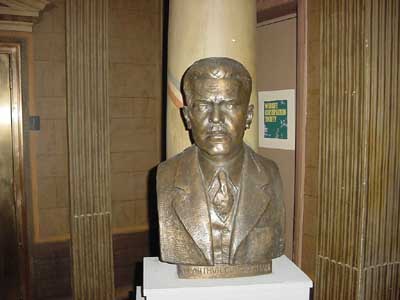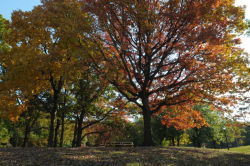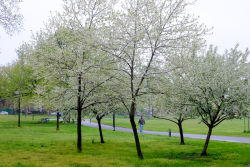Cunningham Park
Cunningham Park
What was here before?
Cunningham Park’s rolling terrain was carved out by glaciers nearly 20,000 years ago. Archaeological evidence indicates that ancestors of the Matinecock, were the first people to settle in the area, arriving about 7,000 years ago. They fished, hunted, and later farmed near the shores of Little Neck and Flushing Bays. Dutch colonists arrived in the area in the early 1600s and were followed by the English. During the American Revolution, British soldiers occupied the area and clear-cut most of the native forests for firewood. The rural landscape of eastern Queens remained largely intact until the economic boom and population explosion of the first decades of the 20th century.
How did this site become a park?
Between 1928 and 1944, the City of New York assembled a series of parcels of land for what was originally called Hillside Park. One of these parcels was the site of the nation's first automobile highway in 1908. The 48-mile private toll road was built by William K. Vanderbilt Jr. and was especially popular with bootleggers during the Prohibition era. Competition from a newly-expanded public highway system put the parkway out of business in 1938. It was donated to the City that same year as parkland, which is now a tree-lined path for walkers, joggers, and cyclists.
In 1936, work was completed by the Works Progress Administration and NYC Parks to develop the southern part of the park. The plan provided tennis courts, playgrounds, stables, bridle paths, playing fields, picnic groves, and parking lots. In the early 1950s, the City of New York acquired land for a greenbelt of public parks along the route of the former railroad that ran from Flushing to Babylon. The Kissena Corridor links Flushing Meadows Corona, Kissena, Alley Pond, and Cunningham Parks in a 2,816-acre, 4.5-mile “emerald necklace” of parkland.
As Queens continued to grow, the park was reduced in size to accommodate the construction and expansion of schools and roads. These projects included Oceania Street (1944), Horace Harding Expressway (1951), J.H.S. 74 and its playground (1952), and the Clearview Expressway (1957-60). For more than thirty years, the Sanitation and Transportation Departments occupied a site on the east side of the park. This area was restored as playing fields in 1986.
In 2019, the picnic area was reconstructed to include new barbecue grills, accessible picnic tables, and plantings. The walking oval was fully recreated with new fitness equipment and mile markers along the pathway. The performance space, sometimes used as an outdoor classroom, was updated for intimate performances and outdoor activities.
Who is this park named for?
This park was renamed for W. Arthur Cunningham (1894-1934) in 1936. Born in Manhattan, Cunningham was raised in Brooklyn, where he attended St. James’s Academy. He received his L.L.B. degree from Fordham Law School in 1915, but postponed his legal career to serve in World War I. Cunningham distinguished himself in combat as a major in the 69th (later 165th) Regiment, American Expeditionary Forces. He served as counsel and later vice president of the Textile Banking Corporation until 1933, when he was elected City Comptroller on Mayor LaGuardia’s fusion ticket. He would die the next year at the age of 39.

Check out your park's Vital Signs
Clean & Safe
Green & Resilient
Empowered & Engaged Users
Share your feedback or learn more about how this park is part of a
Vital Park System
Contacts
Cunningham Park: (718) 217-6452










